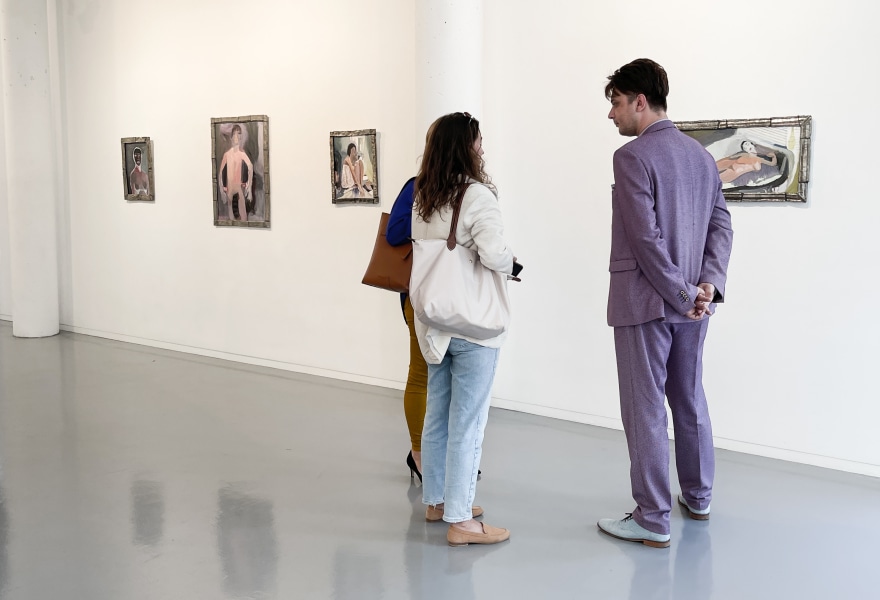05 october 2021, Flor Linckens
Helen Verhoeven: “Painting is a kind of exorcism”
The cheerful visual language of the Dutch artist Helen Verhoeven occasionally conceals dark stories. Verhoeven: “My paintings are often about unpleasant things, but hopefully with a certain light-heartedness, because humour is the best antidote to all misery.” The painter draws on traumatic experiences, which she partly endured and partly sought out. A series of her latest works can be seen in an exhibition at Galerie Stigter van Doesburg (until 9 October).
Verhoeven moved from Leiderdorp to Los Angeles at the age of twelve, for her father's film career. Her parents chose to send her to a public school in LA, because that is simply much more common in the Netherlands. There, she came into contact with aggression, alcohol, drugs, sexually transgressive behaviour and gangs. Her friends even put someone into a coma and via Facebook, Verhoeven finds out that some old classmates are currently in prison. During her training at the San Francisco Art Institute and the New York Academy of Art, she actively sought out intense emotional experiences, although that also left her suffering from panic attacks. She worked in an abortion clinic in a deprived neighbourhood, where she encountered the most heartbreaking situations. Verhoeven: “A very young girl came for an abortion. She had a huge, homemade tattoo of a penis on her stomach. That image haunts me to this day.” She also worked in the emergency room for a while, she dissected corpses in a lab, and helped out at a homeless shelter. Verhoeven: “I have collected an endless well of feelings, in addition to factual knowledge.”
Verhoeven continued her studies at the Rijksakademie van Beeldende Kunsten in Amsterdam and currently lives in Berlin, where she keeps her studio in an old Stasi interception station. During her working process, Verhoeven hermetically closes her studio from prying eyes. Verhoeven: “I feel that making art is extremely private, very personal.” For a while, she made a lot of work about mothers and children, as a way of dealing with the fact that she was unable to conceive. A month later, she turned out to be pregnant [she currently has two children]. Verhoeven: “I think painting is a kind of exorcism process anyway. You let it go and you let it out.”
The Dutch painter is known for her extensive preliminary work: before making a painting, for example, she immerses herself in clinical studies and archives, but also in hagiographies (biographies about saints), mythology and art history. Thematically, she connects universal themes such as fertility and beauty, but also power and death. Her paintings often look very dreamlike, as if you are looking at a vague memory. Verhoeven works in a combination of figuration and abstraction, making use of different textures and patterns, resulting in a kind of collage effect.
In 2015, she completed an ambitious work for the Supreme Court (of 4 by 6.5 metres), which she worked on for 2.5 years. She recently created a number of enormous works, one of which is currently on display in Museum Catharijneconvent in Utrecht and one was recently shown in the Royal Palace in Amsterdam: an impressive and complex group portrait of the Royal family. In addition, she made a number of smaller portraits in the past year, which are more inward-looking. These intimate works are currently on display in the gallery.
Verhoeven's work is included in the collections of the Centraal Museum, the Stedelijk Museum and the Bonnefantenmuseum (where she had a solo exhibition in 2018). Her work can also be found in the collections of Saatchi Gallery, The Museum of Contemporary Art in Miami, DSM, De Nederlandsche Bank, Eneco and Rabobank. In 2008 she won the Royal Award for Modern Painting, followed by the Wolvecamp Prize in 2010 and the ABN Amro Art Prize in 2018.
The exhibition 'Puff Puff Goodbye' will be on show in Galerie Stigter van Doesburg until 9 October.


